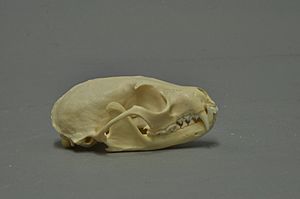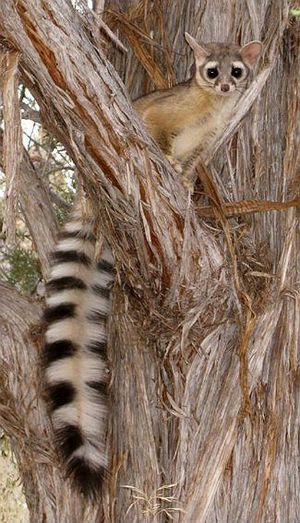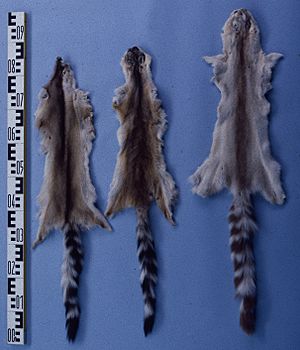Ring-tailed cat facts for kids
Quick facts for kids Ringtail |
|
|---|---|
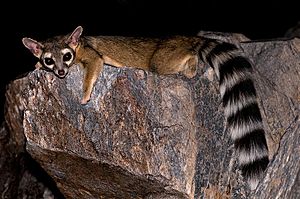 |
|
| Ringtail in Phoenix, Arizona | |
| Conservation status | |
| Scientific classification | |
| Genus: |
Bassariscus
|
| Species: |
astutus
|
| Subspecies | |
|
|
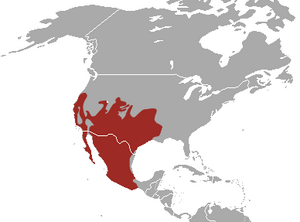 |
|
| Ring-tailed cat range | |
The ringtail (Bassariscus astutus) is a small mammal that belongs to the raccoon family. It lives in dry areas of North America. You can find ringtails in many places, and they are good at living in areas changed by humans. People used to trap them for their fur. Today, the ringtail is listed as "Least Concern" on the IUCN Red List, meaning it is not currently endangered.
This animal is also known by other names like the ringtail cat, miner's cat, or bassarisk. Sometimes, it's called a cacomistle, but that name is usually for a different animal, Bassariscus sumichrasti.
Contents
About the Ringtail: Appearance and Habits
Ringtails have fur that is black to dark brown on top, with lighter fur underneath. Their face has a pointed nose and long whiskers, much like a fox. In fact, its Latin name means 'clever little fox'! Dark fur around its eyes makes its face look a bit like it's wearing a mask.
The most special part of the ringtail is its long, bushy tail. This tail has 14 to 16 black and white rings, making it look striped. The tail is about the same length as its body. Ringtails have short, straight claws that can partly pull back, which are great for climbing.
A ringtail is smaller than a house cat. Its body is about 30 to 42 centimeters (12 to 17 inches) long. Its tail adds another 31 to 44 centimeters (12 to 17 inches). A typical ringtail weighs around 0.7 to 1.5 kilograms (1.5 to 3.3 pounds).
Ringtails are mostly active at night, which means they are nocturnal. They have large eyes and upright ears that help them see and find food in the dark. They are excellent climbers and use their long tails to keep their balance. The rings on their tail can also trick predators. If a predator grabs the tail, the ringtail might escape more easily.
People have sometimes hunted ringtails for their pelts, but their fur is not very valuable. Fur trapping has become much less common now.
Where Ringtails Live: Range and Habitat
The ringtail lives in the southwestern United States. You can find them in southern Oregon, California, eastern Kansas, Oklahoma, Arizona, New Mexico, Colorado, southern Nevada, Utah, and Texas. In Mexico, they live from the northern desert state of Baja California all the way to Oaxaca. The ringtail is even the official state mammal of Arizona!
Ringtails usually live in rocky desert areas. They like to make their homes in hollow trees or old wooden buildings. They are found in deserts like the Great Basin Desert, the Sonoran Desert, and the Chihuahuan Desert. They also prefer rocky places near water, such as canyons, caves, or old mine shafts.
Ringtails are very good climbers because their ankle joints are super flexible. They can rotate their ankles more than 180 degrees! This helps them climb narrow ledges and tree branches. Their long tail helps them balance, and they can even turn around quickly by doing a cartwheel. Ringtails can also climb up narrow spaces by pushing their feet on one wall and their back against the other. For wider cracks, they can bounce between the walls to move up.
Ringtail Diet: What They Eat
Ringtails are omnivores, meaning they eat both plants and animals. This is true for all animals in the raccoon family.
In winter, ringtails mostly eat small animals. These include small birds, rats, mice, squirrels, rabbits, snakes, lizards, frogs, and toads.
Throughout the year, especially in spring and summer, insects and berries are very important parts of their diet. They also eat other fruit. Ringtails enjoy fruits like juniper berries, hackberries, black berries, persimmons, and prickly pears. They have even been seen drinking from hummingbird feeders, enjoying the sweet nectar or sugar water!
Ringtail Reproduction and Life Cycle
Ringtails usually mate in the spring. After mating, the female ringtail carries her babies for about 45 to 50 days. During this time, the male ringtail will bring food to the female.
A mother ringtail typically gives birth to 2 to 4 cubs in a litter. The cubs open their eyes after about one month. They learn to hunt for themselves when they are about four months old. Ringtails become old enough to have their own babies when they are ten months old. In the wild, a ringtail usually lives for about seven years.
Living with Humans: Miner's Cats
Ringtails are known to be quite easy to tame. They can even make affectionate pets and are very good at catching mice. Long ago, miners and settlers often kept pet ringtails to keep their cabins free of pests. This is why they earned the common name "miner's cat," even though they are part of the raccoon family, not cats.
It seems that ringtails would sometimes move into human camps and become accepted by people. This is similar to how some early domestic cats might have become pets. Some scientists even joke that ringtails "domesticated humans" because of this behavior! Miners would often cut a hole in a small box and place it near a stove or other heat source. This gave the ringtail a dark, warm place to sleep during the day. At night, it would come out to clear the cabin of mice.
Images for kids
See also
 In Spanish: Cacomixtle para niños
In Spanish: Cacomixtle para niños



